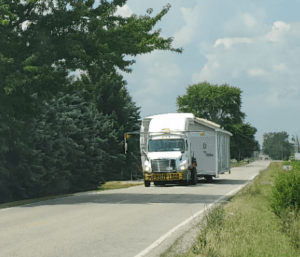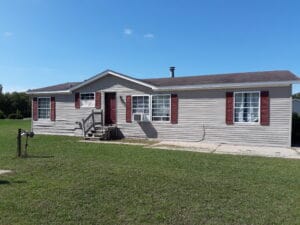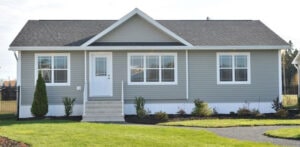If you are trying to figure out if you have a modular home vs. manufactured home , you may think there really isn’t much of a difference but think again.
Modular Home vs. Manufactured Home
It may sound like just some fancy terminology but there are big differences between modular and manufactured homes. Hopefully this article will help you.
In this article we will explore the key differences between modular and manufactured mobile homes. If you have one already you will quickly be able to tell the difference. If you are looking to purchase one this article may help you make a more calculated decision.
Manufactured Mobile Homes
The key thing you will discover about mobile homes is they are built on a steel beam system. This beam system runs the full length of the mobile home. The main beams will always run the length of the manufactured home rather than the width. This beam supports the whole home. These beams are underneath the floor of the manufactured home. If you were to climb under your crawl space you would clearly see them.
Singlewide manufactured homes will typically only have 3 beams. These beams run the full length of the home while doublewides typically have 4. This makes perfect sense more room more beams.
The steel beams better known as I beams are thick manufactured steel. They are engineered to hold heavy loads of weight. When these homes are placed on a crawl space or a basement foundation these beams help to support the weight. They support the home across the entire bottom surface. Cinderblock piers or basement jacks are used under these beams to help support the weight. They distribute the weight across the span to help stabilize the home.
Manufactured Homes: Crawl Spaces and Basements
Tip: If you are looking to place piers or basements jacks to distribute the weight evenly across your manufactured home you can request a blueprint from the manufacturer that will show where to place these.
These beams are also manufactured to withstand the stress of supporting these manufactured homes as they travel down the road. Manufactured home steel beams have areas where axles hook up to them so that these units can be moved down the road. There is also a spot on the end of the manufactured home where you can hook a hitch onto the beams to allow for transportation of the unit. Most hitches are welded onto the frame and sometimes bolts are added to strengthen the connection between the two.
To give your mobile home the look of a real home look into mobile home foundations. Foundations made of block or poured concrete can really give your mobile home beautiful curb appeal.
Manufactured Homes: Moving

Large trucks known as toter trucks will hook onto these hitches and are capable of moving these large units at high speeds down roads. Toter trucks typically require permits and pilot vehicles to be able to move these types of homes. Moving a mobile home is no easy task.
You may be surprised to learn that you can move a mobile home for free. Read our article How to Move a Mobile Home for Free today.
Almost all manufactured home parks have manufactured homes in them not modular homes. These homes sit on piers and then have skirting around them. Once in a while you will see a modular home used as an office in a manufactured home park or you will see a modular at the very front of the manufactured home park to make the park appear nice and elegant.
Tips on Manufactured Homes
If you were to pull back the skirting on the manufactured home, you would typically see axles and a hitch laying underneath the home. Many times, these are left behind to use if you decide you want to move your home later. Do not worry if yours are missing transportation companies typically have these available.
Manufactured Homes Have Titles

Another key give away to a manufactured home is if you have a title to the home. Manufactured mobile homes are the only types of homes that have titles. This is because in every state they are considered a motor vehicle, even though they do not have a motor they still move down the road.
Manufactured mobile homes on private land can be a bit different, the title to the manufactured home can be abolished. Many people do abolish the titles so the manufactured home can be treated as real property. So, if you do not have a title be sure to check under the home to see if it has steel beams.
Benefits of a Manufactured Home
Some of the benefits of a mobile manufactured home over a modular is that you can typically purchase these types of homes for quite a bit less than modular homes.
You also can move these homes much cheaper than modular homes. Singlewides usually run anywhere from $1500 – $4500 to move and doublewides can range from $6k – $10k roughly to move. For rough prices on moving modular homes see below.
When it comes to manufactured homes, you are typically limited on size as well. The biggest doublewide manufactured home typically measures in at 28 x 80 which can provide you with 4 bedroom 3 baths and approximately 2,200 sq ft of living space. These units are limited in size because they must be able to travel down the road. If you are looking for something larger you might want to consider a modular home.
Modular Homes vs. Manufactured Homes
Modular homes are brought in with a crane to your location. These units are very heavy and consist of walls that are prefabricated together just like a normal stick-built home.

Modular homes can be sold and moved from private land but the cost to move these types of homes is awfully expensive. You do not see modular homes move as often as manufactured homes. You will typically spend around $10k just to get a crane to your property to move a modular home. That cost typically does not include the time to break the home down and move it.
Benefits of a Modular Home vs. a Manufactured Home
The benefit of a modular home over a mobile home is that these homes are typically built just like a stick-built home. They just come to your property in sections and are assembled in pieces. These units are built in a factory like setting and are not exposed to outside elements while being constructed. This key factor allows workers to work 24/7 on these homes rather than when weather conditions are ideal.
Modular homes can be quite a bit bigger and offer different dimension sizes as opposed to manufactured homes which can resemble a trailer type look. These homes can be customized to fit your every need, there are no design limitations with these homes. If you want extra windows, bathrooms, or a den these homes can really become your dream home.
Another benefit of a modular home is they are considered real property. Modular homes are homes that have a deed rather than a title. A deed looks like a piece of copy paper, but it will contain important information about your home. Modular homes typically do not depreciate either. They will typically hold value just as a stick-built home would.
Other Things to Consider about Both Types of Homes
Manufactured Homes: Crane Set Up
Sometimes if you have a tricky basement setup or steep hills manufactured mobile homes will be set by crane as well. However, you will know if your home is a manufactured home by the steel beam or if you have a title as discussed above.
Buying a Modular Home
It may surprise you to learn that you can purchase a new modular home from Amazon. When Jeff Bezos decided to launch Amazon.com to sell books, I am not sure that one day he thought he would be selling modular homes from his site, talk about goals.
Financing: Modular and Manufactured Homes
Modular homes can be easier to finance than manufactured homes. If both units are new that may not be as big of a problem. Used manufactured homes have depreciated in value and sometimes that makes it tricky to get financing on these units. Modular homes however are considered real property and are treated like a stick built home so banks are more apt to finance these units.
Modular vs. Manufactured Homes: Similarity
When considering purchasing either a modular or manufactured home there is one KEY benefit. These homes are considerably faster to assemble and put on land than their stick-built counterparts. These homes can be set and ready to live in in just a couple months as opposed to the many months it takes to build a regular stick-built home. So, if you are looking for something quick either option will work.
Modular and Manufactured Home Sites
One last thing to consider is outside of the cost of these homes you also must figure in the cost of the land, the well, the septic, permits, electrical and ductwork. Many of these items are add-ons to the actual cost of the home. Be sure to plan accordingly and have all your ducks in a row when deciding which home will work best for you and your family.
Modular Home vs. Manufactured Home: Conclusion
A modular home vs. manufactured home, both have amazing qualities and features. I hope that this article helped you to weight out your options and make a more calculated choice when it comes to purchasing your next home. Good luck on your journey!
FAQ’s: Modular Home vs. Manufactured Home
Is a double wide the same as a manufactured home?
A double wide is a type of manufactured home. Manufactured homes are prefabricated structures built in a factory and then transported to their final location. A double wide specifically refers to a manufactured home that is wide enough to require two transport sections.
What is another name for a modular home?
Another name for a modular home is a “prefabricated home.” These homes are constructed in sections or modules in a factory and then assembled on-site.
What’s the difference between prefab and modular homes?
Prefab is a broad term that encompasses various types of prefabricated homes, including modular homes. The main difference is that modular homes are built in sections or modules in a factory and assembled on-site, while other prefab homes may be built in one piece, like mobile homes or have various construction methods.
Is a modular home safe in a tornado?
Modular homes can be designed to be more tornado-resistant than traditional stick-built homes. By using sturdy construction materials and techniques, such as reinforced walls and foundations, modular homes can provide a higher level of safety in severe weather conditions like tornadoes. However, the specific safety depends on the design and quality of the modular home.
